
Create Your Fire Emergency Action Plan (Template Download)
A structured approach to a fire emergency action plan is the best way to reduce these threats. Build your own emergency plan with our template.
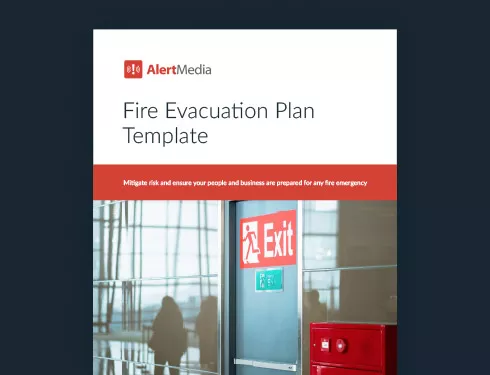
Workplace fires are a severe threat to employees and customers. The most recent data from the U.S. Fire Administration shows over 116,500 nonresidential fires occurring in 2021, with 115 deaths and $3 billion in damages caused. The trends are concerning as these fires have become more common and more deadly in recent years.
As organizations face threats from this type of disaster, it’s critical to establish a fire emergency action plan. You can protect your team, customers, and property through proactive planning and a structured approach to workplace fire prevention and response.
Download Our Fire Evacuation Plan Template
Continuing Progress in Fire Prevention and Protection
Over the past century, progress has significantly reduced fire disaster risks. One major turning point was the Great Chicago Fire of 1871, which burned over 73 miles of streets and left a third of Chicago residents homeless. The fire’s primary cause, aside from an unusually dry summer, was the city’s primarily wooden infrastructure, including wood frame sidewalks and pine shingle roofs. A single ember set off a chain reaction, burning through a significant portion of the city and resulting in numerous deaths.
One positive outcome was the establishment of new laws and regulations around fire safety infrastructure. Brian O’Connor, a National Fire Protection Association technical services engineer, recently discussed these standards on The Employee Safety Podcast with Peter Steinfeld.
O’Connor’s role involves advising on numerous codes and regulations resulting from the Great Chicago Fire and others like it. Today, modern infrastructure incorporates built-in fire safety measures to minimize fire spread in densely populated spaces. Cities are designed with the understanding that there needs to be access for personnel and equipment in the event of a fire.
Businesses play a crucial role in controlling their fire risks. O’Connor also discussed how seemingly innocuous elements, like overgrown shrubbery, are potential barriers for first responders during a fire. Something that might be seen as only a landscaping issue on most days could cause a significant, deadly delay during a fire. The fire department and other emergency responders might be unable to bring needed equipment to reach building occupants trapped inside.
Considering these less obvious risks is a key aspect of fire safety planning. Just as fire codes should seamlessly integrate into a building’s design, from how the stairwells are laid out to the type of sprinkler system used, an organization’s culture must embed a structured emergency action plan. And everyone who could be impacted must understand their roles and responsibilities during a fire emergency.
6 Steps for a Fire Emergency Action Plan
A fire emergency action plan is the backbone of workplace fire safety. This plan goes beyond the common expectations of evacuation routes and annual fire extinguisher inspections. To limit property damage and protect workers, here are six key steps to help you build a fire emergency action plan that works.
- Map your workplace
- Create a safety hierarchy
- Establish your communications plan
- Consider all contingencies
- Plan for known and new hazards
- Document and improve
A structured approach incorporating all those elements is the best way to lay out your plan. To make it easier, download our Fire Evacuation Plan Template to document your strategy.
Preview of our Fire Evacuation Plan Template
1. Map Your Entire Workplace and Escape Routes
Having a well-defined evacuation route is one of the most important parts of a fire emergency action plan. Before you can even think of extinguishing the flames, you’ll need to get everyone to safety.
There are four components to a fire evacuation plan: map, mark, communicate, and assemble.
Map | Mark | Communicate | Assemble |
| Map your existing evacuation route on your building’s blueprints, ensuring these are still the fastest primary routes to safety. On these maps, identify hazards that could become impassable during an emergency and then build secondary routes employees can follow. Finally, note any first aid stations or supplies along the route. | It’s essential to mark routes clearly, but you also need to walk through these routes to get a good idea of how intuitive the evacuation path is. Is the route obvious if an employee can’t see a sign due to thick smoke or debris? If not, consider ways you can make the path clearer with signage and other indicators. | Rather than searching for evacuation routes when the fire alarm starts blaring, employees should know the path they’re expected to take well in advance. Share the emergency evacuation plan and ensure their path is clearly outlined. Regular fire drills can also help to familiarize people with the plan. Smooth communication during a tabletop exercise or drill can translate to smooth communication and a faster response in an actual emergency. | Select an appropriate assembly place that is well away from the hazard. Ideally, it should be around 500 feet away from the building to keep employees clear of any risks. Again, it’s also important to have a secondary assembly area if the primary point is inaccessible. |
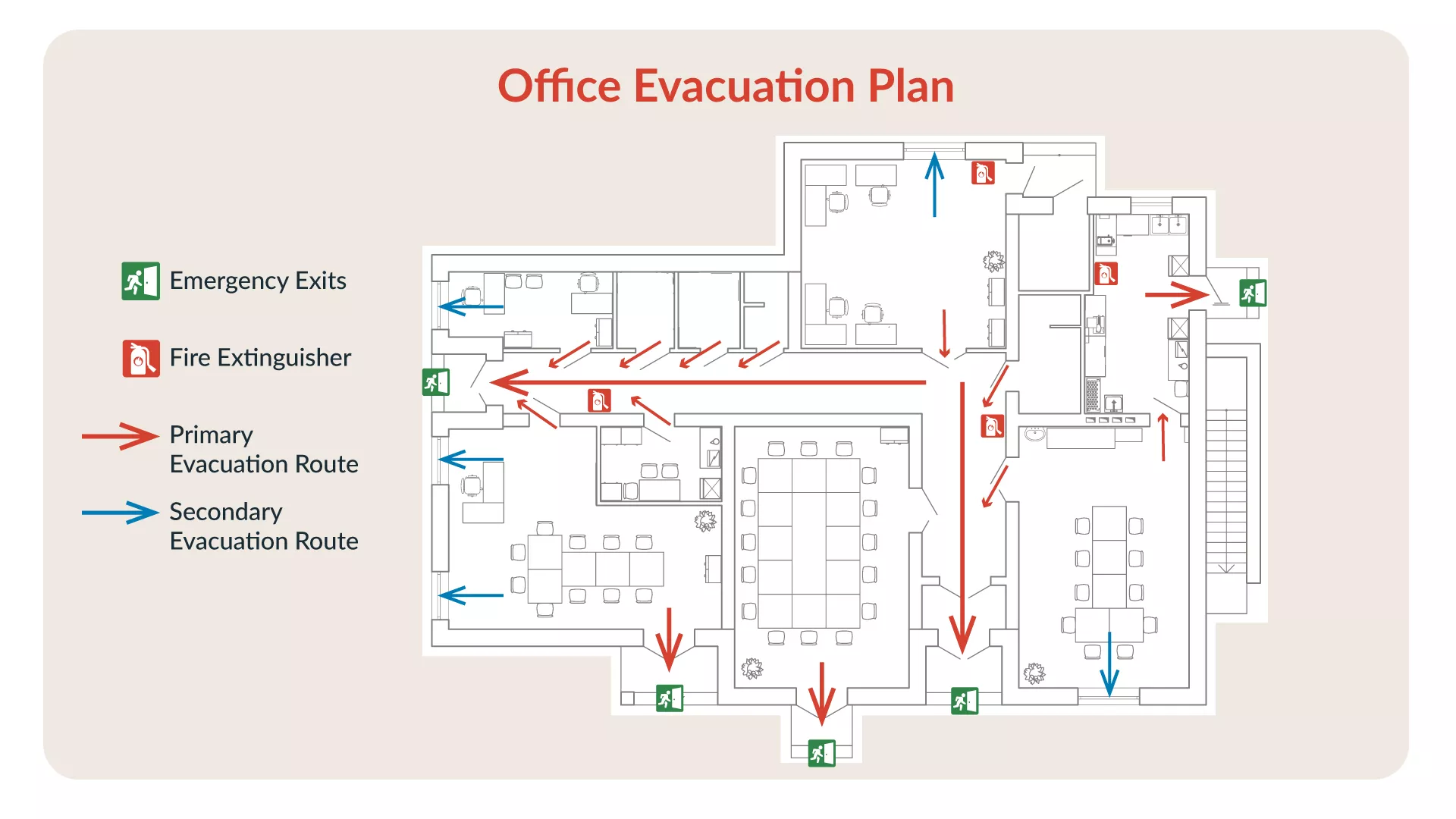
The work dynamics have shifted, with many employees now working remotely or in satellite offices. Extending safety measures to these settings is becoming more critical. Provide resources for employees working from home, including guidelines for creating their own home evacuation and fire safety plans.
For your in-office employees, fire drills will help reiterate the plan in the event of a fire. For an in-depth explanation of how to hold one, see our detailed video guide.
2. Create a Fire Safety Leadership Structure
Creating a fire safety hierarchy is crucial for a well-organized evacuation. Designate specific responsibilities for safety officers, such as communication, route verification, assembly point management, and hazard identification. Duplicate these responsibilities across roles to ensure continuity in case someone is not there or is unavailable.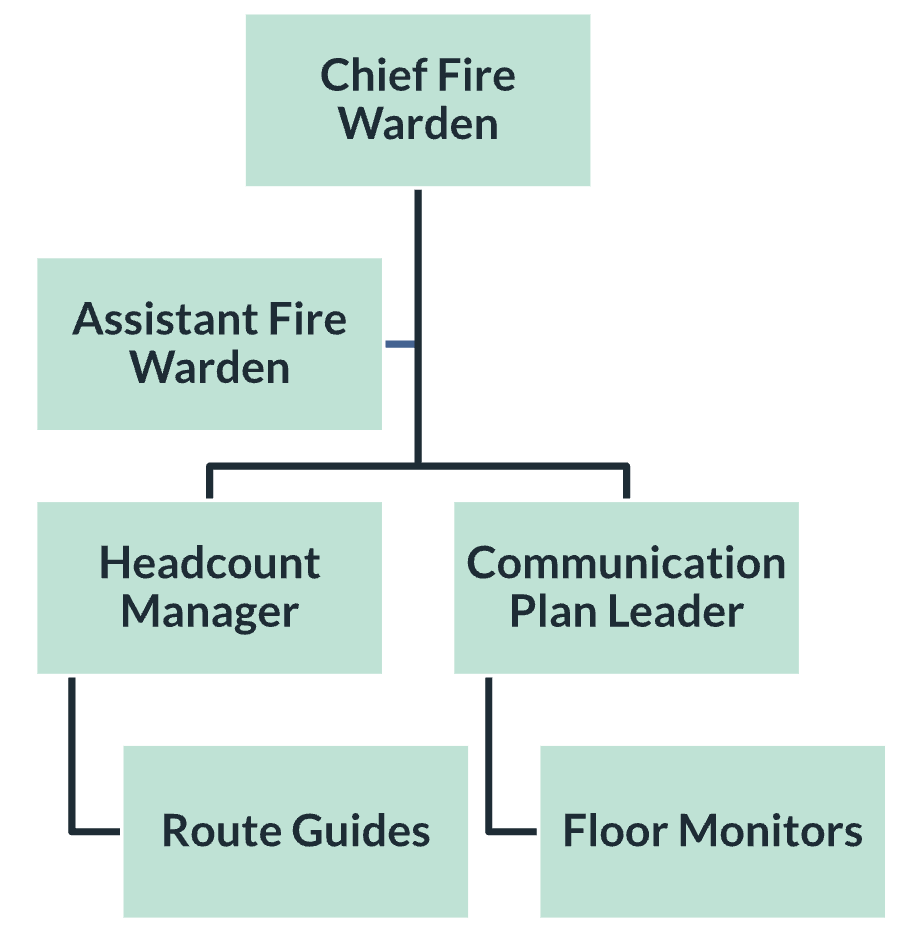
- Chief Fire Warden: The chief fire warden oversees the entire fire safety plan, coordinates evacuation efforts, and liaises with emergency services.
- Assistant Fire Warden: This role supports the chief fire warden in coordinating and executing the fire safety plan, especially in their absence.
- Head Count Manager: This individual will manage the overall safety of designated areas, coordinate with floor monitors, and assist in evacuation procedures.
- Communication Plan Leader: This individual will oversee the dissemination of information among staff, ensuring everyone has the information needed to respond effectively during a fire emergency.
- Route Guides: Route guides each handle a designated evacuation route to ensure employees within their group can exit the building in a fire. They coordinate with the Head Count Manager to keep track of personnel.
- Floor Monitors: Floor monitors are responsible for specific floors or areas, verifying evacuation routes, and assisting individuals during evacuations as needed.
Aside from the chief fire warden, everyone in the safety plan answers to someone else in the chain of command and shares information with those under them. This hierarchical approach ensures that no matter what, employees always know who to go to for more information.
3. Establish a Multi-Faceted Communication System
Many company fire safety communication systems depend on company infrastructure and resources. Hardwired fire alarms, company phone lines, and intercom systems may be the first means of sharing info about the hazard, but they shouldn’t be the last in an emergency response plan.
You need a reliable way to communicate with employees before, during, and after the fire.
BeforeWhile you don’t typically get a lot of warnings in this type of emergency, there are some proactive measures to take.
| DuringEmotions will be high during the fire. Keep communication simple and
| AfterCompany systems may be up and running, but there’s still a lot to communicate during the recovery period.
|
4. Consider Different Fire Types in Your Emergency Plan
There are six different types of fires: those fueled by solids, liquids, gases, metals, and cooking oils and fats, as well as electrical fires. It’s critical to be prepared for all fire types that may threaten your facilities. To be truly prepared, you need to assess the risks of each of the fire types, how to prevent them, and how to respond if these fires do break out. There are six different classes of fire extinguishers designed for different types of fires.
Fire Types |
Fires involving solid combustible materials (e.g., wood, paper, cloth)
| Fires involving flammable liquids and gases (e.g., gasoline, oil, grease) | Fires involving electrical equipment
| Fires involving combustible metals (e.g., magnesium, sodium, titanium) | Kitchen fires involving cooking oils and fats
| Fires of various causes and fuel types (see Classes A, B, and C) |
Extinguishing Agents |
Class A Water, foam, or multipurpose agents
| Class B Foam, carbon dioxide (CO2), or multipurpose agents | Class C Carbon dioxide (CO2) or multipurpose agents | Class D Specialized powders designed for specific metal fires
| Class K Wet chemicals
| Class ABC Multipurpose agents (often dry chemicals)
|
To have the right equipment on hand, you need to know what fire threats your business faces. A financial services center may have no need for a Class K fire extinguisher, but it may be useful to have a Class C for electrical fires in the server room. Meanwhile, a manufacturing facility dealing with combustible metals might find a Class D extinguisher crucial for their safety measures. Understanding the specific fire hazards in your environment allows you to tailor your fire safety equipment and plans accordingly.
5. Address New Hazards in Your Fire Prevention Plan
Hazards in the workplace are not static. While plans may be in place for risks everyone is aware of, like a boiler malfunctioning or an employee leaving a stove on in the common room, new hazards may not be considered at all. Progress has helped us mitigate many fire hazards; it has also created new ones.
This is something NFPA’s Brian O’Connor pointed out on AlertMedia’s podcast. As O’Connor notes, electric cars are slowly becoming more mainstream, presenting unique challenges in the event of a fire. The fumes are more toxic, and the flames are difficult to quell. Businesses with parking garages should consider these types of risks and review how a team will bring in the necessary equipment and evacuate the garage in the event of this type of fire.
These types of batteries are just one example of new hazardous materials and threats in the workplace that you must plan for. Every time you review your fire emergency action plan, you should also consider what new hazards have been introduced since the last time you planned and how you will address them.
Some new fire hazards you may not have thought of in and around the workplace (outside of lithium-ion batteries) may include:
- Flexible office furniture and decor: Modern office designs with flexible furniture and decor may include flammable materials that can contribute to fire spread.
- Smart appliances and devices: The integration of smart technologies in appliances and devices may introduce fire risks if the electronics malfunction or overheat.
- Energy-efficient lighting systems: LED and other energy-efficient lighting systems can pose fire hazards if not installed or maintained properly.
- Remote work setups: Home offices with a variety of electronic devices and makeshift electrical setups may increase the risk of electrical fires. In addition, at-home workers may not have a sophisticated fire alarm system or fire response equipment in place.
- Advanced machinery and robotics: Technologically advanced machinery and robotics in manufacturing may introduce new fire risks, especially if they involve high temperatures or flammable materials.
- 3D printing materials: The use of novel materials in 3D printing, such as experimental polymers, may present unforeseen fire hazards.
- Augmented reality (AR) and virtual reality (VR) equipment: The charging and operation of AR and VR devices may pose electrical fire risks, and the batteries in these devices can be a concern.
- Landscaping changes: If new landscaping elements or a lack of attention to outdoor maintenance diminishes the defensible space, your facilities may be at higher risk of wildfires.
Regular updates to workplace safety protocols, employee training on emerging hazards, and proactive measures in adapting fire safety practices are essential to address these new challenges effectively. In addition, any new hazard should come with a safety data sheet and documented process if things go wrong.
6. Document Your Fire Safety Process and Improve
Improving a fire emergency action plan involves a continuous cycle of assessment and refinement. After documenting the initial plan and exit routes, conduct regular emergency drills and simulations to assess the practicality of the procedures outlined. You may even work with your local fire department, emergency responders, or OSHA to conduct full-scale drills that test your emergency response from beginning to end.
Carefully analyze participants’ feedback and stakeholders’ observations during these exercises to identify areas of improvement. Quickly revise any shortcomings in the plan to ensure it remains adaptive to the organization’s evolving needs.
A template will lay out the steps to help you document your fire emergency action plan and address any gaps. With a structured template, you create a comprehensive reference point that serves as a guide during emergencies and facilitates easy updates and revisions. Progress has been the single biggest factor historically in making fires less common and less deadly in the workplace. Use it to your advantage by continuously updating your emergency escape procedures and keeping your workplace safe.

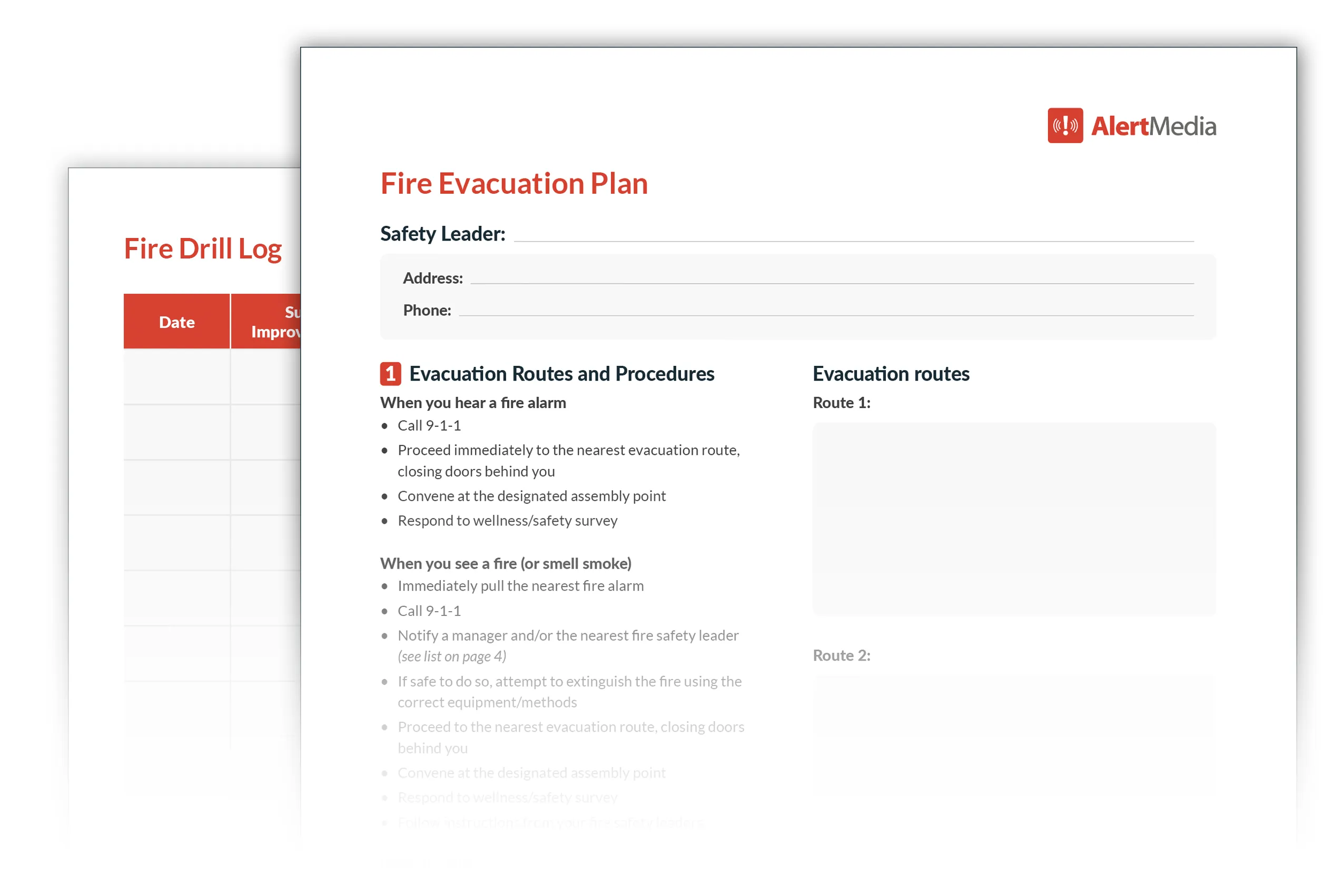

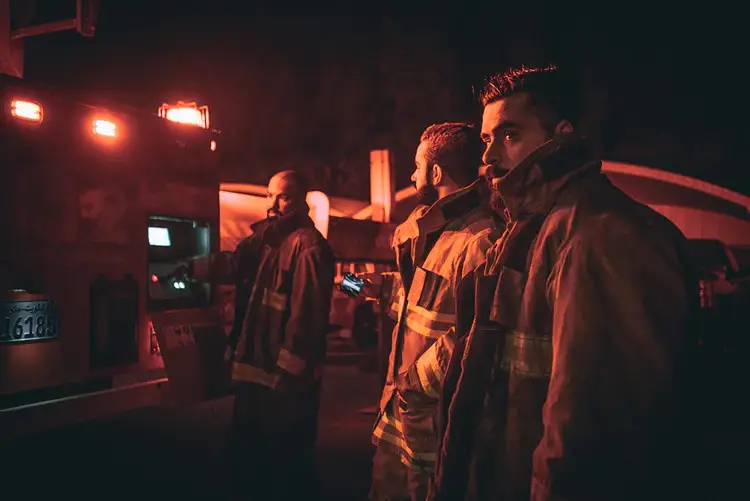

![6 Steps to Creating an Effective Emergency Response Plan [+ Template]](https://www.alertmedia.com/wp-content/uploads/2023/10/Blog-Emergency-Response-Plan.webp)
